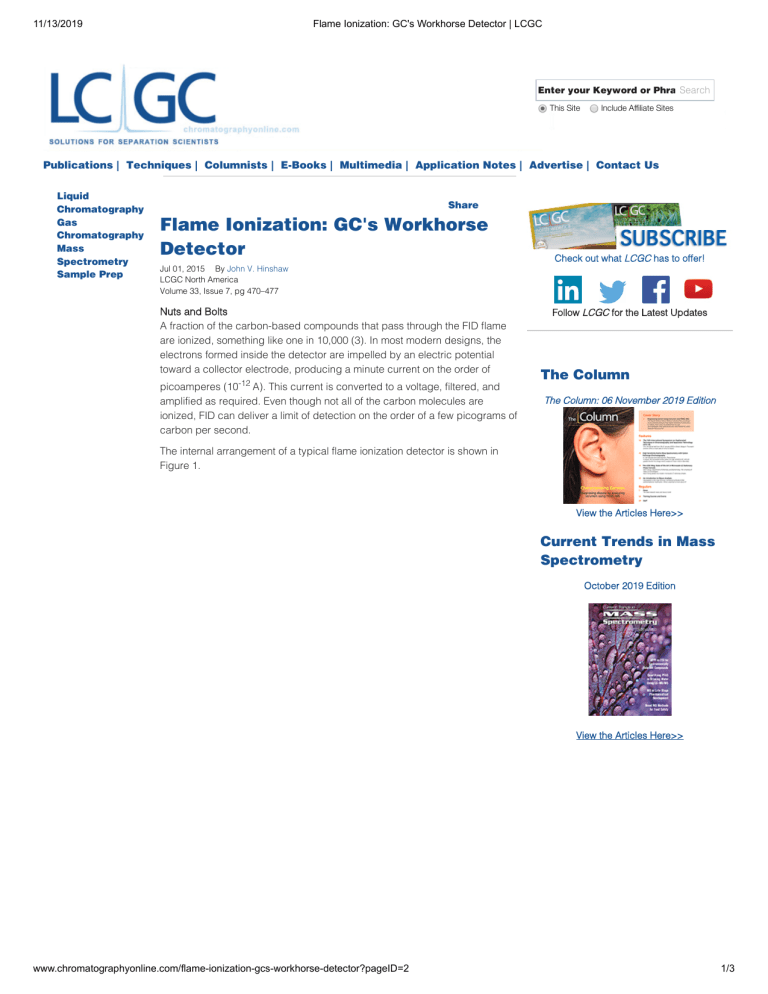
11/13/2019 Flame Ionization: GC's Workhorse Detector | LCGC Enter your Keyword or Phra Search This Site Include Affiliate Sites Publications | Techniques | Columnists | E-Books | Multimedia | Application Notes | Advertise | Contact Us Liquid Chromatography Gas Chromatography Mass Spectrometry Sample Prep Share PrinterSend friendly by version email Flame Ionization: GC's Workhorse Detector Jul 01, 2015 By John V. Hinshaw LCGC North America Volume 33, Issue 7, pg 470–477 Nuts and Bolts A fraction of the carbon-based compounds that pass through the FID flame are ionized, something like one in 10,000 (3). In most modern designs, the electrons formed inside the detector are impelled by an electric potential toward a collector electrode, producing a minute current on the order of picoamperes (10-12 A). This current is converted to a voltage, filtered, and amplified as required. Even though not all of the carbon molecules are ionized, FID can deliver a limit of detection on the order of a few picograms of carbon per second. Check out what LCGC has to offer! Follow LCGC for the Latest Updates The Column The Column: 06 November 2019 Edition The internal arrangement of a typical flame ionization detector is shown in Figure 1. View the Articles Here>> Current Trends in Mass Spectrometry October 2019 Edition View the Articles Here>> www.chromatographyonline.com/flame-ionization-gcs-workhorse-detector?pageID=2 1/3 11/13/2019 Flame Ionization: GC's Workhorse Detector | LCGC Figure 1: Flame ionization detector cross-section. 1 = electrometer connection, 2 = effluent exit, 3 = igniter coil, 4 = igniter power connection, 5 = polarizing voltage supply connection, 6 = air input, 7 = column connection, 8 = hydrogen input, 9 = flame jet, 10 = collector electrode. (Adapted from a figure courtesy of PerkinElmer Instruments.) Carrier gas from the column enters at the bottom of the detector and is mixed with hydrogen combustion gas plus optional makeup gas in the area below the flame jet. This mixture is then combined with an excess of air and burned just above the jet tip. A negative polarizing potential is applied between the jet tip and a collector electrode; as electrons are formed they are accelerated across the jet tip–collector gap by the electric field. Depending on the detector design, either the collector or the jet tip is kept at ground potential; www.chromatographyonline.com/flame-ionization-gcs-workhorse-detector?pageID=2 2/3 11/13/2019 Flame Ionization: GC's Workhorse Detector | LCGC Figure 1 shows a grounded collector design with the electrometer input at virtual ground and the jet tip charged to -200 V. Air, carbon dioxide, and water exhaust gases are vented from the top of the detector body. In most modern FID systems a glow plug operates momentarily to ignite the flame. The electric current from the collector is converted to a voltage by an electrometer and then is amplified, filtered, digitized, and processed as required. Signal zeroing, scaling, and attenuation are performed in the instrument firmware. The detector signal is filtered to remove unwanted highfrequency noise. Noise is produced by instabilities in the flux of ionizable impurities in the carrier gas, by the flame itself, by the electronic circuit, and by induction of stray electromagnetic signals from, for example, nearby cell phones. Excessive noise usually is the result of contamination from a buildup of carbon particles in the detector, poor electrical connections, or incorrect operational settings. Sensitivity FID sensitivity depends on the combustion gas flow rates, the carrier gas flow rate, the flame jet exit diameter, the electric field formed by the relative positions and shape of jet and collector, and to a lesser degree the detector temperature. « Previous 123 4 5 Next » Recommended Reading Helium to Hydrogen — A Change Would Do You Good Troubleshooting GC Columns and Detectors Add new comment About LCGC LCGC Linking and RSS Policy RSS Applied Clinical Trials Advertise with LCGC LCGC Privacy Policy Twitter BioPharm International Contact LCGC Reprints LinkedIn Nutritional Outlook LCGC Home Advertising Terms & Conditions Terms of Use Facebook Subscribe to LCGC Pharmaceutical Executive Pharmaceutical Technology Spectroscopy © 2019 MultiMedia Pharma Sciences, LLC. All rights reserved. www.chromatographyonline.com/flame-ionization-gcs-workhorse-detector?pageID=2 3/3





